The Intel Core i3-7350K (60W) Review: Almost a Core i7-2600K
by Ian Cutress on February 3, 2017 8:00 AM ESTLegacy and Synthetic Tests
At AnandTech, I’ve taken somewhat of a dim view to pure synthetic tests, as they fail to be relatable. Nonetheless, our benchmark database spans to a time when that is all we had! We take a few of these tests for a pin with the latest hardware.
Cinebench R10
The R10 version of Cinebench is one of our oldest benchmarks, with data going back more than a few generations. The benchmark is similar to that of the newest R15 version, albeit with a simpler render target and a different strategy for multithreading.
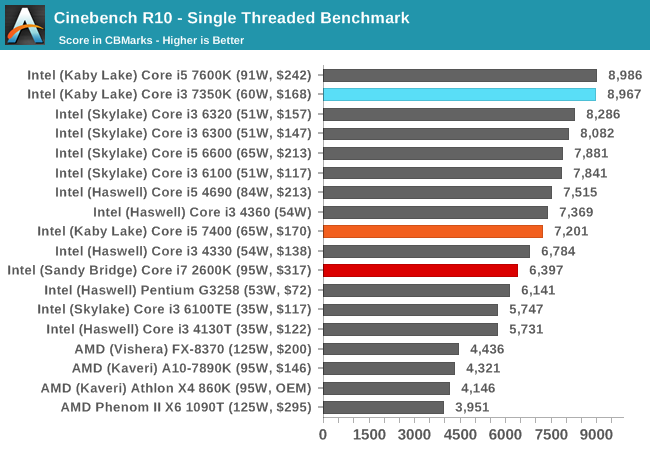
With high frequency in tow, the Core i3-7350K makes its mark.
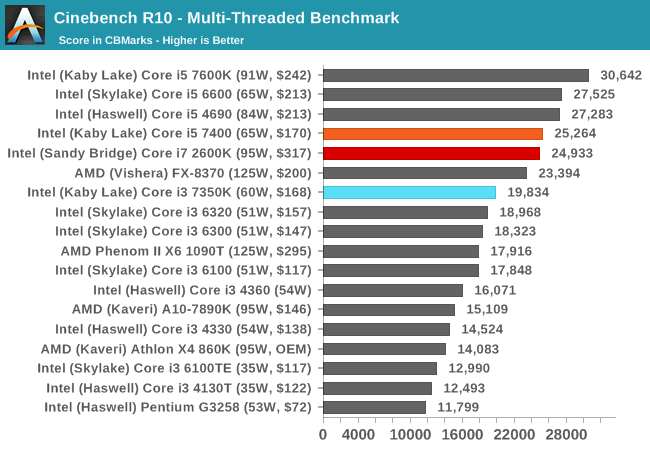
When more threads come to play, the Core i5-7400 and Core i7-2600K battle it out in terms of four cores and IPC vs hyperthreading. The Core i3-7350K sits around ~25% behind.
Cinebench R11.5
CB11.5 has been popular for many years as a performance test, using easy to read and compare numbers that aren’t in the 1000s. We run the benchmark in an automated fashion three times in single-thread and multi-thread mode and take the average of the results.
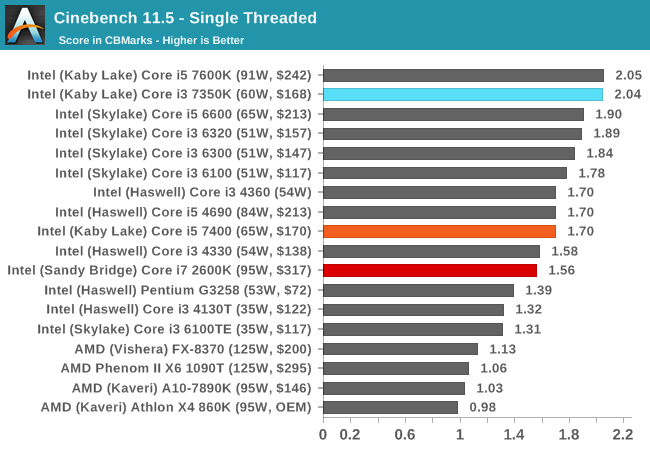
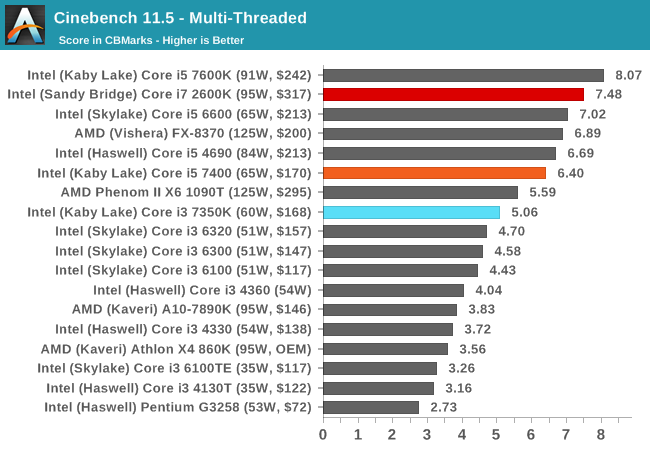
Similar to CB10, the single thread results show that a 4.2 GHz Kaby Lake is nothing to be sniffed at. In the multithreaded test, CB11.5 is more able to leverage the hyperthreads, showing that a Core i7-2600K will run rings around the low end Kaby i5, but is bested by the higher frequency Kaby i5-K. The Core i3 still has that dual core deficit.
7-zip
As an open source compression/decompression tool, 7-zip is easy to test and features a built-in benchmark to measure performance. As a utility, similar to WinRAR, high thread counts, frequency and UPC typically win the day here.
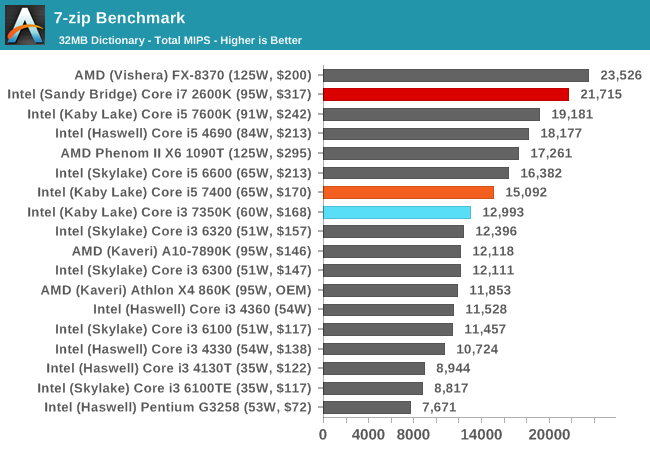
The difference between the i3-7350K and the i5-7400 shows that 7-zip prefers cores over threads, but the Core i7-2600K results show it can use both to good effect, even on older microarchitectures, scoring almost double the i3-7350K.
POV-Ray
Ray-tracing is a typical multithreaded test, with each ray being a potential thread in its own right ensuring that a workload can scale in complexity easily. This lends itself to cores, frequency and IPC: the more, the better.

POV-Ray is a benchmark that is usually touted as liking high IPC, high frequency and more threads. The i7-2600K, despite having double the resources of the Core i3-7350K, is only 30% ahead.
AES via TrueCrypt
Despite TrueCrypt no longer being maintained, the final version incorporates a good test to measure different encryption methodologies as well as encryption combinations. When TrueCrypt was in full swing, the introduction of AES accelerated hardware dialed the performance up a notch, however most of the processors (save the Pentiums/Celerons) now support this and get good speed. The built-in TrueCrypt test does a mass encryption on in-memory data, giving results in GB/s.
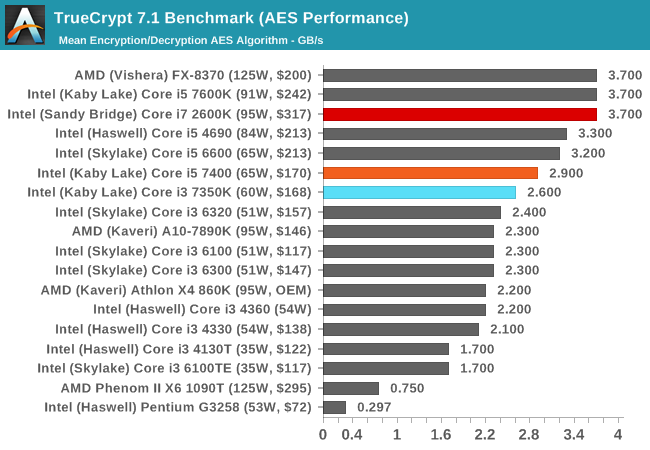










186 Comments
View All Comments
watzupken - Friday, February 3, 2017 - link
A dual core processor is still a dual core processor even if it is unlocked and offers a high clockspeed. I still feel Kaby Lake is a lazy upgrade over Skylake considering it barely offers anything new. Just take a look at the feature page to get a sense of the "upgrades". With competition coming from ARM and AMD Ryzen, is Intel only capable of a clockspeed war just like they did for Pentium 4?CaedenV - Friday, February 3, 2017 - link
Well, to be fair Kabby Lake isn't for you and I. It is Skylake with very minor improvements mostly aimed at fixing the firmware level sleep and wake issues that manufacturers had (ie, the reason Apple didn't move to Skylake until well after release, and the botched deployment of the Surface Pro 4).Outside of that it is just skylake with a minor clock bumb, slightly better thermals, and more of the chip on 14nm.
Shadowmaster625 - Friday, February 3, 2017 - link
So it will be 2025 before an i3 beats a stock 2600K in all benchmarks? That must mean it will be 2030 before it can beat a 4.8GHz 2600K. That's crazy, considering how badly the Core2Quad compares to even a modern celeron.user_5447 - Friday, February 3, 2017 - link
Page 2: "There is one caveat however – Speed Shift currently only works in Windows 10. It requires a driver which is automatically in the OS (v2 doesn’t need a new driver, it’s more a hardware update), but this limitation does mean that Linux and macOS do not benefit from it."This is incorrect: support for Speed Shift (HW pstates) was commited to Linux kernel back in November of 2014, way before Skylake release.
https://lkml.org/lkml/2014/11/6/628
Hinton - Friday, February 3, 2017 - link
Of the 3 CPU'S Anandtech received to review, this was the only one that was marginally interesting (we didn't need a review to know Kabylake performs equally to Skylake).So of course you spent one month before reviewing it. Good for Anand that he took the money and ran.
fanofanand - Friday, February 3, 2017 - link
You may be unaware, but Ian has been kind of busy lately......Meteor2 - Sunday, February 5, 2017 - link
He has? How so?PCHardwareDude - Friday, February 3, 2017 - link
This would be interesting if the part wasn't so bloody expensive. $120 would be interesting.At this price, you're better off spending a little more and getting an i5 or spending a lot less and getting the G4600, which is also dual core kaby lake with hyperthreading.
AssBall - Friday, February 17, 2017 - link
If you have a GPUnotjamie - Friday, February 3, 2017 - link
At £170 this is the exact price I paid for my 3570k almost 5 years ago. That's what I call progress.